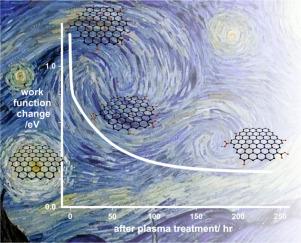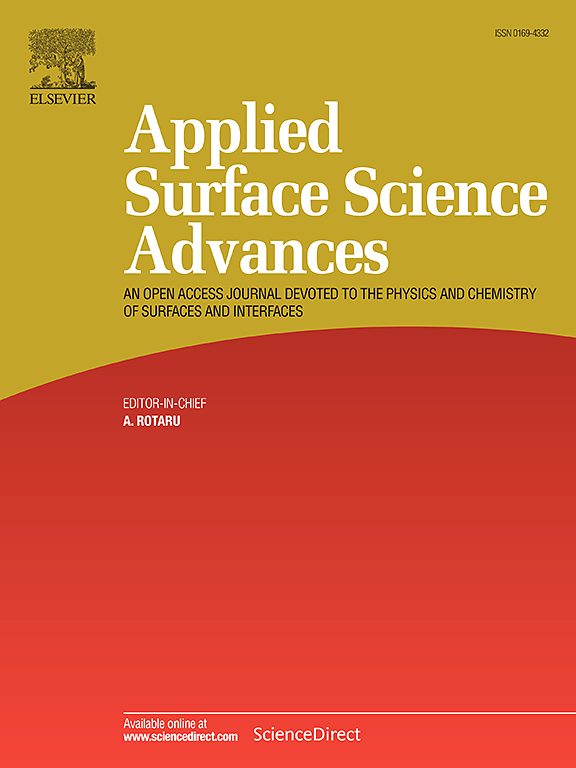探索边缘在等离子体改性碳材料的表面功能化和稳定性中的作用:实验和 DFT 见解
IF 7.5
Q1 CHEMISTRY, PHYSICAL
引用次数: 0
摘要
碳纳米材料的有效表面功能化在各种应用中起着至关重要的作用。我们采用实验技术和密度泛函理论(DFT)相结合的方法,研究了边缘对氧改性碳材料表面官能化和稳定性的影响。以石墨烯纸、高取向热解石墨(HOPG)和石墨烯薄片为模型系统,采用氧等离子体处理(发生器功率 100 W,氧压 0.2 mbar,曝光时间 6 - 300 s)作为改性方法。使用扫描电子显微镜 (SEM)、X 射线光电子能谱 (XPS) 和拉曼光谱对其表面形貌和化学成分进行了表征。结果显示,所研究的碳表面引入了氧官能团(XPS 高达 20%),而等离子体改性后材料的结构完整性保持不变(扫描电镜、拉曼光谱)。功函数被用作监测表面变化的敏感参数(石墨烯纸、HOPG 和石墨烯薄片的功函数分别增加了 1.4 eV、1.3 eV 和 1 eV),而随时间变化的测量揭示了官能化衰减的独特动力学过程,突出了表面缺陷在等离子体后过程中的作用。DFT 计算为表面过程提供了分子层面的见解,阐明了羟基扩散、羟基重组和水脱附的基本机制。由于基底石墨烯平面(∼1.0 eV)和边缘(∼5.5 eV)上计算出的重组活化势垒截然不同,因此可以得出结论:持久官能化是由于表面边缘造成的。我们的发现有助于加深对碳材料表面改性过程的理解,并为设计具有定制表面特性的先进功能纳米材料提供了理论依据。本文章由计算机程序翻译,如有差异,请以英文原文为准。

Exploring the role of edges in surface functionalization and stability of plasma-modified carbon materials: Experimental and DFT insights
Effective surface functionalization of carbon nanomaterials plays a crucial role in various applications. We investigated the impact of edges on surface functionalization and stability of oxygen-modified carbon materials using a combination of experimental techniques and Density Functional Theory (DFT) insights. Graphenic paper, highly oriented pyrolytic graphite (HOPG), and graphenic flakes were employed as model systems, with oxygen plasma treatment (generator power 100 W, oxygen pressure 0.2 mbar, exposure time 6 – 300 s) serving as the modification method. Surface morphology and chemical composition were characterized using scanning electron microscopy (SEM), X-ray photoelectron spectroscopy (XPS), and Raman spectroscopy. The results revealed the introduction of oxygen functional groups on the investigated carbon surfaces (up to 20 at % by XPS) whereas; the structural integrity of the materials remained intact upon plasma modification (SEM, Raman). Work function was used as a sensitive parameter for monitoring the surface changes (increase by ∼1.4 eV, 1.3 eV, and 1 eV for graphenic paper, HOPG, and graphenic flakes, respectively) while time-dependent measurements revealed distinct kinetic processes governing the decay of functionalization, highlighting the role of surface defects in post-plasma processes. DFT calculations provided molecular-level insights into the surface processes, elucidating the mechanisms underlying the diffusion of hydroxyls, their recombination, and water desorption. Since the calculated activation barrier for recombination on basal graphenic planes (∼1.0 eV) and edges (∼5.5 eV) are distinctly different, it can be thus concluded that the persistent functionalization is due to the surface edges. Our findings contribute to a deeper understanding of surface modification processes of carbon materials and offer rationales for the design of advanced functional nanomaterials with tailored surface properties.
求助全文
通过发布文献求助,成功后即可免费获取论文全文。
去求助

 求助内容:
求助内容: 应助结果提醒方式:
应助结果提醒方式:


